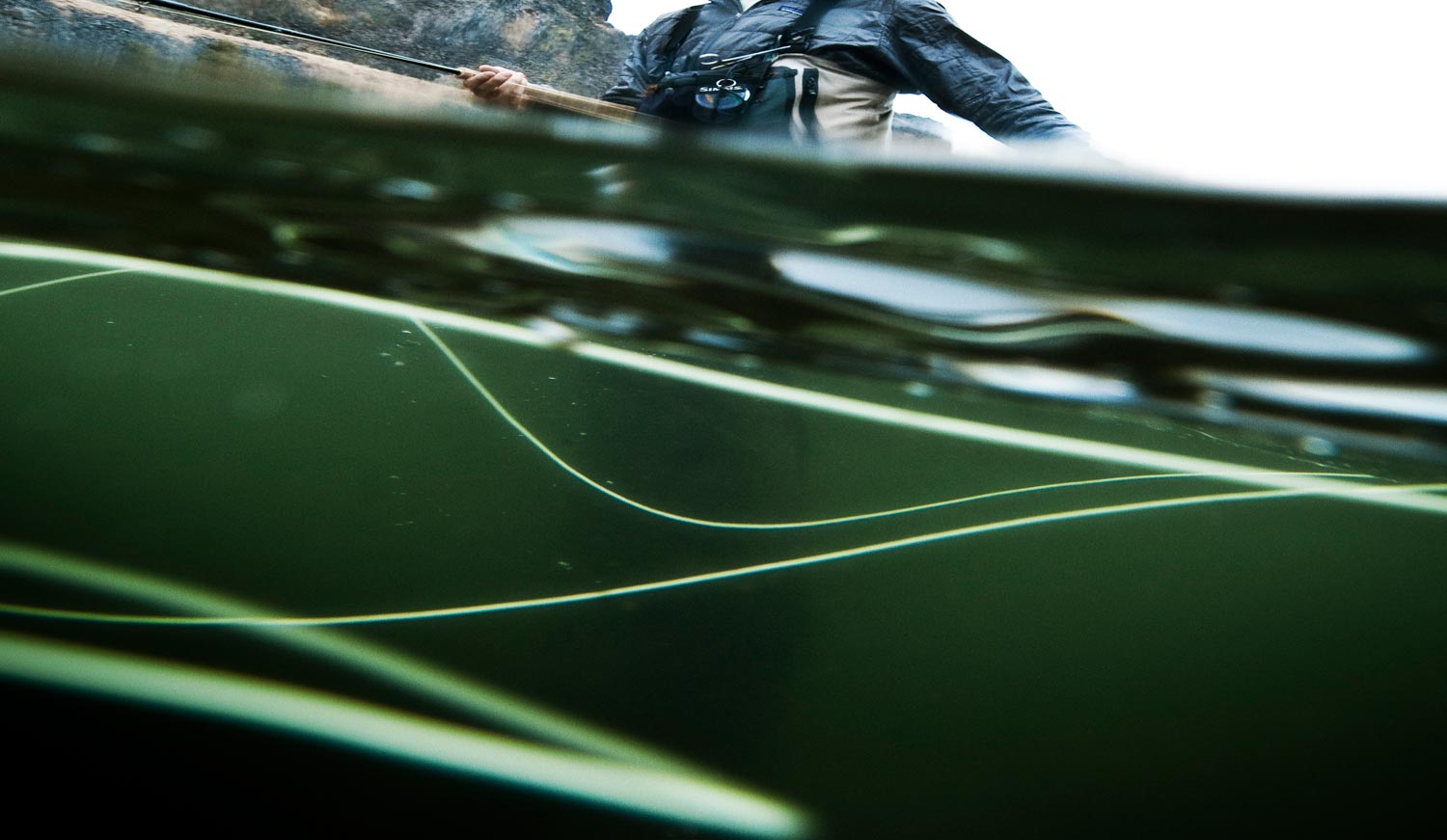Golden Dorado: “Rumble in the Jungle”
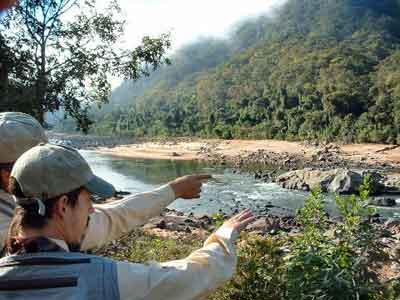
Our guides read the waters for likely holding spots for big golden dorado.
ALEJANDRO HANDED ME the rod. “Now,” he said, “you catch beeg, beeg goldfish.” The Argentine looked me hard in the eye, and the scent of the coca leaves in his mouth wafted gently to my nose in the noontime heat.
“Okay?” he asked.
“Yessir!” I said.
“So go!” he ordered. “Cast!”
We were standing on a rock above the swift tropical stream of southern Bolivia’s Rio Grande de Tarija. Above and around us were mist-wrapped Andean foothills, clothed in a jungle that is home to more than 250 species of exotic birds, as well as spectacled bears, jaguars, tapirs, nutria, and capuchin monkeys. Below us, in the crystal water, flashed the spectral glint of a golden predator, lying in wait for its next unsuspecting meal.
And I could see that it was, indeed, a beeg one.
The only way to reach this fish was to cast upstream and then let the current sweep my streamer around the face of the massive boulder beneath which the dorado lay. I surprised myself with an accurate upstream cast and right away began a fast retrieve. As the leader reached the rock, a large fin broke the surface with a splash of gold.
The line trembled, my heart thumped, and I thrust out my hand to strip again. I pulled violently at the line, tensing my muscles to take the strain of forcing the hook into the dorado’s bony jaw, but what had half a second before been there was no longer. The line, alas, had been too slack, and, spurning the inedible Deceiver, the now wary dorado had returned to its lair.
Alejandro hid it well, but he was, to put it mildly, disappointed. On the other hand, I was encouraged to actually see one of these wary fish come to my offering, even if I didn’t hook it. It was only the first day of our trip. I could, I reckoned, reasonably expect that fishing a more typical downstream swing, I would eventually catch one.
Precious Metal
The golden dorado is known to science asSalminus maxillosus, and to romantics as “the tiger of the Amazon.” It sits at the very pinnacle of its food chain. The largest recorded example weighed in at 68 pounds of raw, carnivorous power, and it seems likely that they come a good deal larger than that. Typical sizes on the Tarija are in the 6- to 25-pound range, with the ever-present possibility of something that will rip your arms from their sockets.
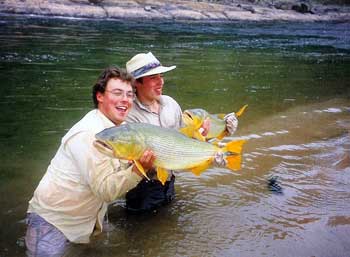
Gustavo Hiebaum and Mateo Montiel show off the results of a double-header. The bigger fish tipped the scales at 15 pounds, the smaller at about half that.
Dorado have enormous heads, and their powerful jaws are full of gleaming, razor-like teeth. They generally move in small groups, chewing their way through a catholic variety of prey — fish and frogs, birds and mammals. In the Tarija, the dorado are particularly fond of sabalo, a schooling fish of two to six pounds, which a dorado can swallow in a single gulp. The presence of sabalo, detectable from the surface bubbles that they create, is an almost certain indication that dorado are nearby.
In spite of the Salminus in its scientific name, the dorado is unrelated to the salmonids — nor is it related to the saltwater fish also called “dorado.” It lives in the warm waters of the Plata and Amazon systems, in Brazil, Argentina, Paraguay, Uruguay, and Bolivia. In the slower-moving lowland streams and marshes, closer to population centers, the species has been a regular quarry for anglers for many years, and it is well known for the excitement it provides. But only a few pioneers, our guide Alejandro Montiel among them, have so far pursued it with the fly in the less accessible, but spectacularly beautiful, upper reaches of its range.
Our dorado-chasing party comprised Alejandro; his 16 year-old son, Mateo; two affable guides from Southern Cross Outfitters, Gustavo Hiebaum and German Finara; and me. The day I missed that fish, we’d driven in Alejandro’s 4X4 until the road (a generous term) had breathed its last in a tangle of lush vegetation. We were deep in Bolivia’s remote and seldom-visited Tariquia Flora and Fauna National Reserve, at an elevation of around 3,500 feet, in the midst of the largest example of Andean yunga — mountainous cloud forest — in the whole of South America.
Rushing over its bed of sand and boulders, the clear Rio Tarija cuts a gray-pink gash through the green of the surrounding forest. It was so far from my notion of dark and turgid tropical rivers, awash with leeches and unnumbered lethal creatures, that on first seeing it I was struck dumb. This pristine fast-flowing upland river is custom-made for anglers addicted to the pursuit of fish with fly.
And what a fly it is!
I’d been warned that fishing for dorado would be like saltwater fishing on a river. On our first morning, Alejandro produced a gaudy, 3-inch feather bundle tied on a 2/0 hook. I wanted to say (if only I spoke Spanish) You really expect me to cast that thing? Which was, of course, exactly what he expected, and exactly what, to limited initial effect, I tried to do on my 9-foot, 9-weight rod.
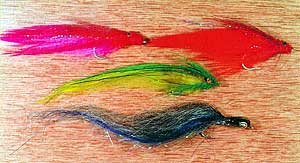
Saltwater streamers — especially large Deceivers — are the standard dorado patterns. I found orange-and-white to be a productive combination, while other time-tested colors are black, white, orange-and-black, red-and-yellow, red-and-white, and purple-and-white. Anglers have also met with success with Lefty's Half and Halfs, Whistlers, Cockroaches, and Clouser Minnows. Sizes for all of these should be in the 1/0 to 4/0 range. David Klausmeyer photo
On dry land, Alejandro’s streamer — made with the home-dyed feathers of roosters bought from local Indian farmers — looked like an accessory for a hooker’s coat; but when I saw it wiggling fishily in the stream, it was easy to understand how such a thing would scream Eat Me! to a greedy golden predator. Alejandro tied it to the end of a braided-wire tippet, above which, in the nylon leader, he had put two bimini twists to absorb the shock of driving the hook into a dorado’s jaw. To set the hook, you must strip-strike, tugging directly on the line, rather than raising the rod tip.
When I did catch a fish, this tactic worked well. But my fish, at 7 or 8 pounds, were “dinks,” although energetic enough for me to feel the long trip well worthwhile. With bigger dorado, more care is called for. Mateo learned this painfully on our first day out, when he hooked what was, without a doubt, a huge fish. As the monster took off, he failed to release the line from his retrieving hand, and the fish dragged it across his palm and fingers, searing his flesh so deeply and painfully that his hand was bandaged for the entire trip — a warning to the rest of us.
Into the Wild
Our base for our four days of fishing on the Tarija was at Santa Clara, an Indian hamlet three hours in the 4X4 from the nearest town of Bermejo, where we had entered Bolivia from Argentina. It was 90 minutes over even rougher terrain to the farthest point of our penetration into the Tariquia reserve. Santa Clara is relatively untouched by modernity. Roosters announced the dawn from every yard; cattle grazed freely at the roadside; and on our morning drive to the river, smiling children popped up out of the undergrowth on their way to the one-room village school. There’s no electricity and no phones. Engines are rare, and there is no flight path in the sky above.
Occasionally as we fished, an Indian would emerge from the shadows of the jungle, one cheek bizarrely distended by a golf-ball sized bolus of coca leaves. Otherwise, we were alone with the sounds of the sounds of the wilderness — the afternoon breeze in the trees, the tropical river bubbling and roaring towards the distant sea, parrots squawking in the treetops, and, every so often, of one of our party excitedly announcing the presence, on the end of his thoroughly modern line, of another muscle-bound dorado.
The loudest call of all went up as I was sitting on a rock at a place called Cajon Chico — a rocky narrowing, where the jungle comes close to the edge of the water. I was resting my aching arm after hours of casting and retrieving, watching the yellow-bills of the toucans as they hopped among the treetops and occasionally glancing admiringly at Alejandro, as he shot out a tight-looped line with a stylishness that would make him a big hit at any fly-fishing show.
Suddenly and urgently, Alejandro began to reel in. He turned towards me and held his arms wide apart.
“Mateo!” he shouted. “Beeg, beeg fish!”
With that he scampered off across the boulders and disappeared from sight.
I jumped up, too, and began to make my way, more gingerly than Alejandro had, to where I’d seen Mateo fishing a few minutes before. But the boy was gone. I heard shouts and looked downstream. True to his dramatic instincts, Mateo was leaping from rock to rock six feet or more above the foaming current, chasing a fish that had already stripped 150 yards of line and backing from his reel. I watched as Alejandro heaved his son up the sheer face of a house-sized boulder, and then I made my way downstream by an easier route.
Mateo’s headlong rush ended at last about 400 yards from where he’d hooked the dorado. The river had opened out and was clear of obstructions, and there was nowhere left for the fish to hide or break off. Mateo’s task now was to ease the fish towards him, keeping the line tight so that the fish could not chew its way up the wire tippet to the nylon.
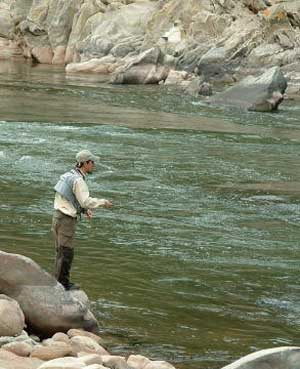 Soon we could make out a shadowy golden shape, and then, a few minutes later, Alejandro was inserting the rubber-coated jaws of his scale into the fish’s mouth. Its weight and length established — 17.6 pounds and 32.5 inches — Mateo cradled the magnificent creature in his arms for a few quick photographs and the crowd’s admiration of its massive head and rich gleaming gold, red, and black coloring. Then he slipped it quickly back into the water and sent it on its way.
Soon we could make out a shadowy golden shape, and then, a few minutes later, Alejandro was inserting the rubber-coated jaws of his scale into the fish’s mouth. Its weight and length established — 17.6 pounds and 32.5 inches — Mateo cradled the magnificent creature in his arms for a few quick photographs and the crowd’s admiration of its massive head and rich gleaming gold, red, and black coloring. Then he slipped it quickly back into the water and sent it on its way.
On the Frontier
Not many people have fished with the fly on the Tarija, and not many ever will. It’s a long way away, at the end of an execrable road, in what is, after all, the poorest country in South America. The fishing is challenging and there are often long intervals between fish (although this causes none of the bleak suicidal desperation that, for example, a dead week on a Scottish salmon river can engender). Even with a 4×4 at hand, this is not a place for the infirm: in most places there are steep descents on foot to the river (and correspondingly enervating climbs back up again at the end of the day) and at least a moderate degree of agility is required to negotiate the river’s rocky banks. If you have a non-fishing spouse or partner who insists on never letting you out of his or her sight, he or she, unless a dedicated ornithologist or botanist, would almost certainly find the conditions Spartan, the diversions few, and the nightlife disappointing.
All that said, these fish are special. The challenges of persuading a dorado to take your streamer in this crystalline water, and of firmly hooking it, are to be savored even by the most skilled and blasé angler. The adrenaline rush from fighting the most powerful freshwater fish of all is no ordinary one, and once it’s landed, the sheer beauty of the fish is astonishing. You don’t need to be catching a dorado every few minutes to see the point of the exercise. And these magnificent fish live in a place of almost magical beauty. The river itself is close to fly-fishing perfection, and the jungle around it is filled with wildlife and plant life of a rich variety.
The people of Tarija are untrained, thank heaven, in the art of pandering to tourists. When I was there, in mid-June, the weather was well-nigh perfect, with cool damp nights and days in the 70s or 80s with, surprisingly (considering the dampness of the nights and the ever-present hill-top clouds) low humidity. Biting bug populations were extremely modest, too, and the bug dope came out mostly when we broke for lunch in jungle clearings.
The charm and future conversational value of doing what few have done, in a remote and beautiful place that few have visited, is not to be sniffed at. For a North American it is, certainly, a long way away; but for anyone who would consider a trip to Patagonia, let alone New Zealand, the journey would be little hardship for a fly-fishing experience that is, in some very special ways, unique. The time, moreover, is a good one. With the approach to Tarija best made from Argentina, and the current peso-dollar rate, it is unlikely that the trip will ever be more reasonably priced.
If You Go
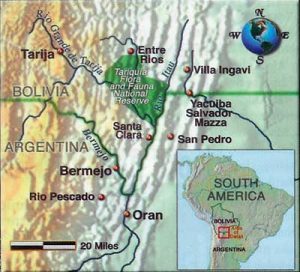
Illustration by Bill Tipton

Illustration by Bill Tipton
Getting There
The easiest way to get to the Tarija is via neighboring Argentina. San Salvador de Jujuy, in the northwest, has the nearest airport, with one scheduled two-hour flight a day from Buenos Aires. From there, it’s a three- to four-hour drive over good tarmac roads through sugar cane plantations and citrus groves to the Bolivian border near the town of Bermejo, and then another three hours over increasingly poor dirt roads to the virtually imperceptible village of Santa Clara.
Doing It With Help
My trip was arranged by Southern Cross Outfitters, which is currently the only guiding operation with access to the restricted waters of the Tariquia Reserve. Patagonia-based head guide Gustavo Hiebaum and his colleague German Finara are highly competent, professional, and extremely good company. Alejandro Montiel was all of these things, and also intimately acquainted with the river and the best methods of catching big dorado. Particularly important, perhaps, are his established relationships with the various representatives of Bolivian officialdom, and his evangelizing commitment to conservation of all kinds, and in particular to catch-and-release fishing. This is, however, a new venture for Southern Cross Outfitters, and something of a work in progress. They have plans for making the journey less arduous by flying clients into San Ramon de la Nueva Oran, the closest sizable Argentine town to the Bolivian border, thus avoiding the dull drive up from Jujuy, and for upgrading the currently rather basic cabin. It is unlikely, however, that it will ever be a luxury resort, and nobody should go there unless they intend to fish.
Seasons and Weather
The dorado season on the Tarija runs from June through November — winter and spring in the southern tropics. Temperatures in June normally peak at around 90 degrees, although it was cooler during our trip. The humidity is surprisingly comfortable during the days, once the mist has burned off, and very high during the cool nights. Later in the season, the weather becomes warmer and stickier, and it is important to make sure you have adequate drinking-water supplies to avoid dehydration.
Typical tropical fishing attire is perfect, with the supplement of a fleece or other warm top for the evenings and early morning. Only your foolish writer wore waders for even one day, during which, in spite of the fact that they were among the lightest available, he was slow-cooked until he almost expired. Wet wading is the thing here, so take fast-drying pants and appropriate footwear to deal with the sometimes slippery rocks. A good hat and sunscreen are essential.
Medical Preparations
You will be in the tropics and some distance from medical help or from any way of even calling for it. Get a yellow-fever shot, and protect yourself against malaria. Carry the sensible traveler’s range of off-the-shelf medications, and ask your doctor for a prescription for a course of antidiarrheal antibiotics.
Cost
Southern Cross Outfitters (248-626-3101; www.southerncrossoutfitters.com) charges $300 per night, per person. This fee includes lodging, all meals, guiding, and transportation from and to the airport in San Salvador de Jujuy.
Julio Mazzoli of Southern Cross says that he has consistently found the best airfares to Argentina through a travel agent named J. C. Rivero at First In Service Travel in New York City (212-398-6555, Ext. 272). Mr. Rivero specializes in travel to South America, and he knows all the tricks to cutting costs. In general, you should expect to pay between $800 to $1,200 to get to Jujuy during the fishing season, depending on your departure city.









